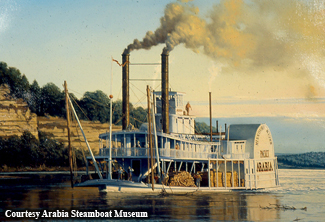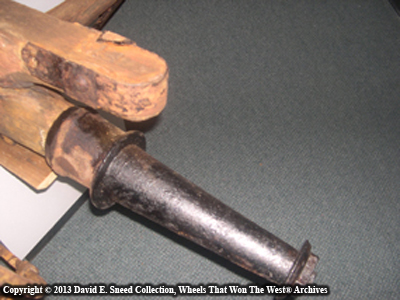Looking as far back as the 1700s, many of the earliest American wagons employed wooden axles with tapered ends that were fitted with a pair of iron strips called clouts. The bottom clout would understandably wear faster than the top clout. Developing a system that would increase the durability and reduce maintenance in this area became a priority for many builders. Ultimately, the cast thimble skein (a hollow metal cone tightly fitted over the axle end) replaced clouts and became the system used by virtually all makers using wooden axles.
As recent as a decade or so ago, some sources felt that the use of thimble skeins on wagons would likely date to a time during or immediately prior to America's Civil War in 1861. Even so, one of the first solid contradictions to that timeframe occurred after the discovery of a wagon gear on board the buried remains of the Steamboat Arabia. Since the boat was well documented as sinking on the Missouri river in 1856, its contents provide indisputable and historically accurate insights into what existed at that time. Several years ago, I wrote a feature article published in the Carriage Journal magazine identifying the gear as one built by Peter Schuttler in Chicago.

Beyond being the oldest known Schuttler survivor, this 1856 workhorse was factory-equipped with threaded thimble skeins a full 5-years before the war. Incredibly, we've since uncovered patents for these types of skeins that were granted as early as the mid-1840s. With the admission in some patent files that hollow cone skeins were commonplace before the 1850s, it's clear that the technology was in use far in advance of the War-Between-The-States.

So, who was it that came up with the invention? It's a good question and one that seems a bit clouded by the passage of time. In 1882, a period account clearly gives Louis Espenschied of St. Louis, Missouri (Espenschied Wagon Company) kudos for the innovation during his early days of blacksmithing and wagon making. Another report dating to 1975 seems to propose Ed Bain (Bain Wagon Company) as the champion of the design. Unfortunately, we've been unable to locate a single 19th century account that would corroborate that claim for Bain. Since Mr. Bain did not enter the wagon business until 1852, and earlier patent records do exist for thimble-type skeins, it seems questionable that he could have been responsible for this innovation. Conversely, knowing that period historical credits were given to Espenschied and finding no 19th century challenges to those credits, it's difficult to avoid acknowledging Mr. Espenschied as the inventor. Certainly, he was deeply involved in the trade - in the 'Gateway to the West' no less - prior to the earliest patents appearing. His later 1878 patent on a self-lubricating skein also shows a continued focus related to this innovation.

Similar to other historical curiosities, there may always be questions related to the invention of the thimble skein. What is consistently reinforced through this and other research is just how competitive the early wagon and carriage industry was. There are thousands upon thousands of old patents for vehicles and vehicle parts in the forgotten files of the U.S. Patent and Trademark office. Each is yet another reminder that time marches on and definitive history is preserved only when we ask questions, seek proven answers, and record the results.
Feel free to drop us a line at info@wheelsthatwonthewest.com anytime you have questions or materials you'd like to share. We'd enjoy hearing from you.
